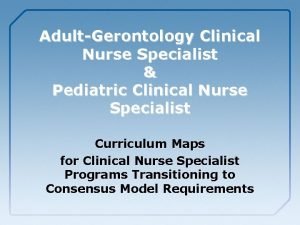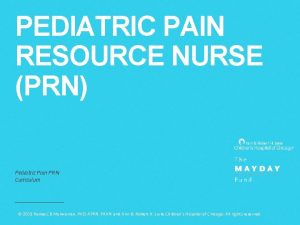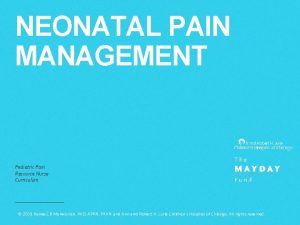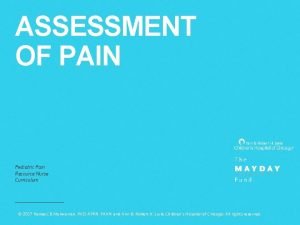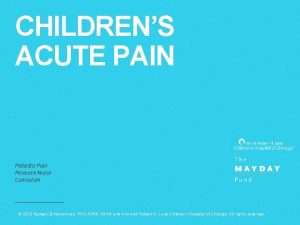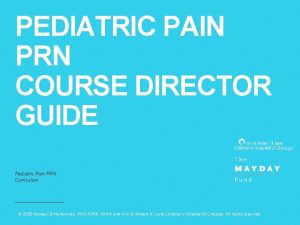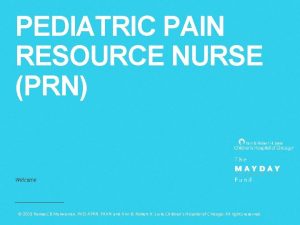DATA TO INFORM CHANGE Pediatric Pain Resource Nurse













- Slides: 13

DATA TO INFORM CHANGE Pediatric Pain Resource Nurse Curriculum © 2019 Renee CB Manworren, Ph. D, APRN, FAAN and Ann & Robert H. Lurie Children’s Hospital of Chicago. All rights reserved.

Understand data sources and the analytic process What do actionable data look like? • Where can you focus your first effort for the quickest win and biggest reward? • Who are key members of your team? • Do you have the resources you need to secure success? | 2

SMART goals and metrics Ideal Goals & Objectives Performance Measurement Ideal Metrics Specific Sensitive: Can measure the difference that Performance Improvement Measurable Achievable Relevant Time-bound really happens Meaningful: The patients & the providers agree that what is measured is important Accurate: Valid and precise Reliable: Means the same with repeated measurement Timely: The data are on time for decisions | 3

Measures Example: procedural pain in children Processes 1. Start at the end & work back • What is the expected change in practice? (Pain assessment, comfort plan, evidence-based interventions) • What are indicators of that change? (Documentation of pain assessments, comfort plan, intervention) • How can they be measured? 2. Look at the literature • What is currently measured? • How hard would new data be to collect? Engage clinical experts when needed Start at the end and work back Look at the literature Engage clinical experts Outcomes 1. Start at the end and work back • What is the expected outcome of this change? ( procedural pain) • What are indicators of that outcome? (Pain ratings) • How can they be measured? (Documentation review) 2. Look at the literature • What is currently measured? • How hard would new data be to collect? Engage clinical experts when needed | 4

Process your thinking! Why did you choose that answer? . Define your measure and identify how to get it. | 5

The Analytic Process The analytic process is an uncertain and complex process you will need to steer through. It cannot be fully delegated. Knowledge Attitude • Staff knowledge • Practice • Technique • Staff perception • Importance • Priority Behavior • Staff behavior • Technique • Compliance checks PROCESS 1. State the hypothesis or analytic question Outcome • Outcomes • Patient • Staff • Cost OUTCOME 1. Assess the data 2. Define the path to answer it üAre the data clean enough? üAre the data representative enough? üLit review (pay attention to methods sections) üIdentify potential data sources üDevelop comparison approach üIs this plan feasible? üTend to outliers, inter-relationships, underlying patterns üAnything unexpected? üIt must be falsifiable 3. Systematically collect & prepare data for analysis üVast amount of time and resources involved 2. Begin statistical testing 3. Final testing üAssess reproducibility üWhat makes you uneasy? | 6

What is Nursing Informatics? Nurse informatics specialists review clinical needs and documentation input, work flows & utilization. The goal is to use technology to gain wisdom. Current nursing informatics standards are published in the Nursing Informatics: Scope and Standards of Practice, 2 nd ed (2015). Data, information, knowledge, and wisdom model Data Nursing Informatics is a specialty that integrates nursing science with multiple information and analytical sciences to identify, define, manage, and communicate data, information, knowledge, and wisdom in nursing practice Information Knowledge Wisdom Discrete entities that are described objectively without interpretation Data that has been interpreted, organized, or structured Information that is synthesized so that relationships are identified and formalized Appropriate use of knowledge. For PRNs wisdom involves judgment about knowing what options are most appropriate for managing children’s pain. The PRN must be able to place measures of pain in context of a particular patient’s and families situation and be able to interpret the meaning of pain assessment and treatments. | 7

Implications for Informatics and Documentation of Pain Response “If you don't know where you are going, any road will get you there. ” ~ Lewis Carroll Informatics tools facilitate pain documentation. The PRN should contact nursing informatics or other organizational resources to ensure tools populate based on age and establish the workflow if the patient does not fit standard criteria. “If you don't know where you are going, you will probably end up somewhere else”. ~Laurence Peter Pain assessments and responses to treatments are usually documented in a flow sheet of the EHR. Ensure that this documentation is visible, so it can be acted upon by all relevant healthcare providers (HCPs). Documentation should portray the patient’s pain experience, so HCPs can use this knowledge to continue or modify the treatment plan. | 8

Measuring and Improving Outcomes If interventions fail to achieve the expected outcome, it may be an implementation failure, rather than failure of the intervention. If practice change is not implemented as intended (low fidelity), outcomes may fail to improve (e. g. , if steps are skipped, pain scores or satisfaction may not improve). Balancing measures determine risk associated In order to change with practice change. outcomes, you need Deciding if the outcome met the intended goal to change processes. for improvement and understanding risks is key to making next steps decisions. Although outcomes can be measured, they can only be managed through improvements in care processes. • Processes are steps for improvement (e. g. auditing pain assessment documentation) • Outcomes are goals for improvement (e. g. interventions given in response to pain) • Balancing measures monitor for systemic effects and unintended consequences from | practice change (e. g. respiratory depression). 9

Implications of Informatics for the Pediatric PRN Tools are available to the PRN to incorporate appropriate resources into patient electronic health records (EHR) to document care that meets unique cultural, ethnic, and religious values and beliefs. As technology advances, the EHR will evolve to: • advance the patient story in the documentation of health care across the continuum of care. • focus on health • incorporate or download patient centric information to personalize the EHR. Plans of care should focus on patient-generated goals. Ideally, pain experiences, including all pain histories, assessments, treatments and evaluations of treatment efficacy, will flow into patients’ personalized plans of care. | 10

Key Points A Pain Resource Nurse (PRN) is a registered nurse who interfaces with healthcare team members, patients, and families as a resource, change agent, and leader to disseminate information, facilitate optimal pain management, and systemize quality pain care. • Leadership commitment to PRN and PRN role is critical for success. PRN responsibilities include: PRNs influence care at the unit, specialty, organization, and community level PRNs should lead projects that facilitate optimal pain management and systemize quality pain care • Personal Professional Development • Clinical • Educator • Researcher • Change agent • Leader Clinical standards • PRNs champion and facilitate quality, leadership, pain management and ethical standards When implementing the PRN role… • Establish an interdisciplinary team to explore opportunities for improvement, identify barriers, develop an action plan, champion change, and monitor outcomes. • Use communication, trust-building and listening skills. Identify high-impact opportunities • Identify and implement change: Question, Evidence, Teamwork, Pilot, and Disseminate Your role as a Change Agent • Phase project implementation to create awareness and interest, build knowledge and commitment, promote action and change, and plan integration and sustained use. • Identify specific data sources and outcome measures. Leverage Informatics Advocate for patients and families • Tailor the pain-related information to the patient and family. | 11

Checklist: Instituting Evidence. Based Practice “The reason most people never reach their goals is that they don’t define them, or ever seriously consider them as believable or achievable. Winners can tell you where they are going, what they plan to do along the way, and who will be sharing the adventure with them. ” ~Denis Watley q Define units, patient populations to extend evidence-based practice q Decide on written resources needed for implementation q Select opinion leaders q Quick reference guides. q Select change champions q Patient/education forms. q Select core group members q Decision tree. • Establish timelines q Plan for and make system changes as needed (e. g. , documentation forms, etc. ) • Keep them involved q Plan baseline data collection • Outline responsibilities q Decide on initial education • Who? • Process indicators • Outcome indicators • Opinion leader • Frequency • Change champion • Initial feedback to staff • Core group • Graphs • Staff • Who • Methods • When • Posting q Plan for education of new staff q Plan for annual competency review q Audit and feedback of data • Frequency • Where to post q Celebrate progress and success | 12

What’s your plan? Write your next steps here. • Review the characteristics for implementing the PRN role successfully. What do you still need? • Review the types of projects PRNs can take responsibility for. Which can immediately benefit your clinical unit or specialty? • Review the checklist for instituting evidence-based practice. Who needs to be on your interdisciplinary team? • Think about your own professional development. Who can be your mentor? | 13
 Define child health nursing
Define child health nursing Pediatric clinical nurse specialist programs
Pediatric clinical nurse specialist programs Pediatric dysphagia resource guide
Pediatric dysphagia resource guide Mad pain martian pain
Mad pain martian pain Period symptoms vs pregnancy symptoms
Period symptoms vs pregnancy symptoms Period vs pregnancy
Period vs pregnancy Responsibility of scrub nurse
Responsibility of scrub nurse Nurse logic ati
Nurse logic ati Resource leveling is the approach to even out the peaks of
Resource leveling is the approach to even out the peaks of Contoh resource loading
Contoh resource loading Is mashing potatoes a physical or chemical change
Is mashing potatoes a physical or chemical change Chemical change and physical change
Chemical change and physical change Absolute change and relative change formula
Absolute change and relative change formula Define integers
Define integers

